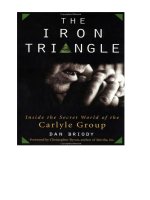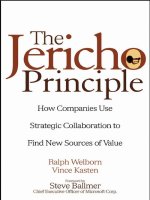John wiley sons whois afraid of adam smith how the market got its soul
Bạn đang xem bản rút gọn của tài liệu. Xem và tải ngay bản đầy đủ của tài liệu tại đây (1.54 MB, 240 trang )
TE
AM
FL
Y
WHO’S
AFRAID OF
ADAM SMITH?
WHO’S
AFRAID OF
ADAM SMITH?
HOW THE MARKET GOT ITS SOUL
PETER J. DOUGH ERT Y
JOHN WILEY & SONS, INC.
Copyright © 2002 by Peter J. Dougherty. All rights reserved.
Published by John Wiley & Sons, Inc., Hoboken, New Jersey.
Published simultaneously in Canada.
No part of this publication may be reproduced, stored in a retrieval system, or transmitted in
any form or by any means, electronic, mechanical, photocopying, recording, scanning, or
otherwise, except as permitted under Section 107 or 108 of the 1976 United States Copyright
Act, without either the prior written permission of the Publisher, or authorization through
payment of the appropriate per-copy fee to the Copyright Clearance Center, Inc., 222
Rosewood Drive, Danvers, MA 01923, 978-750-8400, fax 978-750-4470, or on the web at
www.copyright.com. Requests to the Publisher for permission should be addressed to the
Permissions Department, John Wiley & Sons, Inc., 111 River Street, Hoboken, NJ 07030,
201-748-6011, fax 201-748-6008, e-mail: permcoordinator @ wiley.com.
Limit of Liability/Disclaimer of Warranty: While the publisher and author have used their best
efforts in preparing this book, they make no representations or warranties with respect to the
accuracy or completeness of the contents of this book and specif ically disclaim any implied
warranties of merchantability or f itness for a particular purpose. No warranty may be created
or extended by sales representatives or written sales materials. The advice and strategies
contained herein may not be suitable for your situation. You should consult with a professional
where appropriate. Neither the publisher nor author shall be liable for any loss of prof it or any
other commercial damages, including but not limited to special, incidental, consequential, or
other damages.
For general information on our other products and services, or technical support, please contact
our Customer Care Department within the United States at 800-762-2974, outside the United
States at 317-572-3993 or fax 317-572-4002.
Wiley also publishes its books in a variety of electronic formats. Some content that appears in
print may not be available in electronic books.
Library of Congress Cataloging-in-Publication Data:
Dougherty, Peter J.
Who’s afraid of Adam Smith? : how the market got its soul / Peter J. Dougherty.
p. cm.
Includes bibliographical references and index.
ISBN 0-471-18477-2 (cloth : alk. paper)
1. Smith, Adam, 1723–1790. 2. Capitalism—Moral and ethical aspects. 3.
Economics—Moral and ethical aspects. 4. Globalization—Moral and ethical aspects.
Business ethics. I. Title.
HB501 D673 2002
330.15′3—dc21
2002072551
Printed in the United States of America.
10
9
8
7
6
5
4
3
2
1
5.
For Peter Bernstein
“However selfish soever man may be supposed, there are
evidently some principles in his nature, which interest him
in the fortune of others, and render their happiness necessary
to him, though he derives nothing from it except the
pleasure of seeing it.”
Adam Smith, The Theory of Moral Sentiments
We must encourage capitalism, it being the hope for the poor of the
world and being in any case what we are, but our capitalism need
not be hedonistic or monadic, and certainly not unethical. An aristocratic, country-club capitalism, well satisfied with itself, or a
peasant, grasping capitalism, hating itself, are both lacking in the
virtues. And neither works. They lead to monopoly and economic
failure, alienation and revolution. We need a capitalism that nurtures communities of good townsfolk, in South Central LA as
much as in Iowa City.
Deirdre N. McCloskey
Socialism is not the only enemy of the market economy. Another
enemy, all the more power ful for its recent global triumph, is the
market economy itself. When everything that matters can be
bought and sold, when commitments can be broken because they
are no longer to our advantage, when shopping becomes salvation
and advertising slogans become our litany, when our worth is
measured by how much we earn and spend, then the market is destroying the very virtues on which in the long run it depends.
Jonathan Sacks
Preface: Sympathy
for the Dismal
Morals and metaphysics, politics and political economy, the way to make
the most of all the modifications of smoke, gas, and paper currency; you
have all these to learn from us; in short, all the arts and sciences. We
are the modern Athenians.
Thomas Love Peacock
No real Englishman, in his secret soul, was ever sorry for the death of a
political economist.
Walter Bagehot
n January 1985, in my capacity as an editor of economics books, I attended the annual New Year’s meeting of the American Economic Association (AEA), held that year in Dallas. The events coordinator of the
Dallas Convention Center, the same venue that had hosted the Republican
National Convention a year earlier, must have been the wickedest wit—or
most witless wonder—in the West, for he or she had booked, into one side
of the Center, 5,000 dismal scientists—economists—and into the other,
the National Cheerleaders Association.
I
ix
x
P R E FAC E
TE
AM
FL
Y
In nearly 20 years of dragging my holiday-weary bones to the AEA
meetings, I’ve never enjoyed any economists’ convocation quite so much
as this one. Every so often, having tired of meeting, greeting, and talking
textbooks with the predominantly middle-aged, overwhelmingly male,
relentlessly gray-suited economists, I could stroll behind the movable wall
that split the convention center beyond the dismal din, and there sample, if
only momentarily, the neon universe of cheerleaders—all bouncing pompoms and gleaming smiles, and not a gray suit anywhere.
And yet, in the generation since I’ve been working with economists
to publish their books, if there is a group in our society that deserves to
f lash a toothsome grin and maybe even wave a pom-pom or two, it is
the dismal doctors of economics themselves. Whatever may befall us in
the decades to come, the past several have been a time of triumph for
economists, their students, their clients, and, most of all, their ideas.
Even during recession, the world expects capitalism to bounce back
more or less according to the economists’ playbook—which is dramatically more than could have been asked for only a few generations ago,
when competing economic systems were still very much in view. Darwin, for the time being, can take a back seat: We live foursquare in the
age of Adam Smith, author of the two foundational works of modern
economic society: The Wealth of Nations and The Theory of Moral
Sentiments.
Market Wrap
The transition from central planning to markets, the restructuring of
corporations, the liberalization of world trade, the surge in technological
innovation, the spread of the international division of labor, the revolution in finance, the privatization of many public services, the rise of
strategic management, the changing economic status of women, and the
coming of a multinational commercial culture—what economists term
the second great globalization—have generally conformed to the canon
of modern economics.1
Add this recent record to the remarkable rise in living standards
achieved throughout commercial society since the Industrial Revolution,
and the relative stability of the major western economies since World War
Team-Fly®
Preface
xi
II, and even the most stoic, cloistered, test-tube economist has reason to
feel pride in the legacy of Adam Smith. To an impressive degree, the
world now runs according to his rules, revised and updated for the changing times. To paraphrase a prominent economist, economic reality has
come to resemble the model.2
The economists’ recent run of success would seem to give more powerful credence than ever to the prophetic words of that most eloquent of
self-described academic scribblers, John Maynard Keynes, who noted:
“Practical men . . . are usually the slaves of some defunct economist.”3 Defunct or otherwise, economists have had not only their day, but, of late, an
entire era. There is little reason to expect their inf luence to wane, much
less to end. If economic events take a turn for the worse, the demand for
economists and their ideas will only increase, and their inf luence will only
improve. Economists, while not being wholly dismal, do hold an option on
gloom.
An Undismal Dispatch
This book is a personal report from an observer on the economists’ side of
the convention f loor, the gray-garbed assemblage that has produced some
of the multichrome ideas that have inf luenced and will continue to inf luence the lives of practical men and women—and even blessedly impractical cheerleaders—everywhere.
Economic ideas in the tradition of Adam Smith are to democratic capitalism what an operating system is to a computer. The possibilities for
capitalism, as for computing, are prodigious, depending on what we make
of them; but they are only as good as the instructions that drive the respective systems.
In the chapters that follow, I hope to persuade you that our society
will continue to benefit from the instructive economic legacy of Adam
Smith, but also—dare I say more so—from contemporary economists’ recently revived transfiguration of Smith’s lesser known, yet surpassingly
powerful, civic, social, and cultural legacy, lodged in the phrase “moral
sentiments.” This moral dimension of Adam Smith gives market society
its soul, and this soul could very well reveal itself in unanticipated and exciting ways in the decades to come. How it came into being, faded from
xii
P R E FAC E
center stage in the theater of ideas, and returned to meet the challenges of
our day, is the subject of my story.
Accounts Payable
I admire the British bibliographic practice of restricting acknowledgments
to a spartan few, and I will be happy to abide by that tradition if ever I
write another book. However, in this case, I have too many debts to pay
in full.
Typically, a first-time author dedicates his or her book to a family
member. It is only a small stretch to say that Peter L. Bernstein, to whom
this book is dedicated, comes under this definition. I honor the day in the
late 1980s when, in my capacity as a book editor at The Free Press, I
called Peter, a celebrated Wall Street economist, to ask him about his
book-writing plans. Since then, I have edited three of his marvelous, bestselling books.
Several years ago, after I had given a talk at the University of California, San Diego, on my approach to social science publishing, which I called
“Recombinant Ideas and Enlightenment Ideals: Making Capitalism Work,”
I sent a copy of the talk to Peter. Peter liked the talk and featured it in
his newsletter, Economics and Portfolio Strategy. Moreover, he saw in it the
possibility of a book—specifically, this book. Peter urged me to talk to his
editor, Myles Thompson, then a publisher at John Wiley & Sons, about developing the talk into a book proposal, which I did.
After I began to write this book, Peter Bernstein pushed, prodded,
poked, and pulled the chapters out of their primordial maw. He combined
his knowledge of economic history and macroeconomics with his shrewd
literary sensibility—and his seemingly bottomless red pen—and delivered
advice with what I can describe only as a father’s sensitivity. He got me, a
book editor, to learn the book-writing process as an author. Peter is my
dear friend and I am eternally grateful to him.
In the late ’Eighties, I was also introduced to another invaluable associate and friend who ultimately had a hugely formative inf luence on this
book. While at The Free Press, I had the good luck to sign the distinguished author and historian, Jerry Z. Muller. While working with him
on his 1993 book, Adam Smith in His Time and Ours: Designing the
Preface
xiii
Decent Society, Jerry opened my eyes and my imagination to the work
of the great philosopher Adam Smith.
My experience with Jerry made me appreciate Smith’s style of thinking—namely, that Smith had puzzled out a progressive concept of society
and retrofitted it with the incentive structures necessary to achieve a
broadly humane vision. This intellectual style has conditioned my own
thinking and informed my efforts to reckon the lofty ideas of social
philosophers with the f lintier prescriptions of economists in my publishing. Jerry did not read this book in its manuscript form, but I hope that
when he reads it in published form, he will see his ideas as being effectively served. I am deeply indebted to him.
Robert K. Merton, with whom I had the great privilege of working
some 20 years ago (he was my adviser during my days as a yearling social
science editor), also played a direct and an indirect role in the publication of
this book, for which I am grateful. When I sent Bob a copy of the aforementioned San Diego talk, he was kind enough to forward it to Jonathan
Imber, who, much to my gratitude, published it in the Fall 1997 issue of
The American Sociologist. Indirectly, Bob Merton’s intellectual inf luence,
resonant with the Smithian principle that form follows function in the way
we attempt to shape our destiny, has governed my own way of thinking as
well as my publishing—and, certainly, this book. The example of this great
man has never left me since the summer day in 1979 when I met him in
the Oak Room of the Plaza Hotel.
Several friends, authors, and associates read drafts of this manuscript,
and I am most thankful to them for their criticisms and observations.
Richard Swedberg, Shlomo Maital, James Meehan, Mike Elia, Romesh
Vaitilingam, and, especially, Daniel Chirot (who read two drafts) sent me
valuable comments on the chapters. I hope I have done them proud in rendering their wisdom in my revisions. Shlomo was generous in inviting me
to deliver my first chapter as a talk at the June 2001 meetings of the Society
for the Advancement of Behavioral Economics, which he organized, with
Hugh Schwartz, at George Washington University in Washington, DC.
My own loving family, Elizabeth Hock and Colman Dougherty,
had their patience tested well beyond reasonable saintliness as they
watched me litter my home office and our den with files, books, articles,
diskettes, and bad nerves in the preparation of this volume. Liz did double duty by lavishing her considerable editorial skills on the final draft.
xiv
P R E FAC E
Cole did yeoman’s work by constantly reassuring me that I hadn’t lost this
chapter or that file in the remote recesses of my computers. My mother,
Vera Dougherty, is hardly an enthusiast of Enlightenment ideas, but having
raised three sons in extraordinarily trying circumstances, she exhibited,
and continues to exhibit, the kind of moral sentiments that even Adam
Smith would have regarded as heroic. So, too, did my late father, Joseph A.
Dougherty—soldier, barkeeper, and family man—whose memory daily inspires my better sentiments.
As they awaited the completion of this manuscript, Jeanne Glasser,
Joan O’Neil, and Jeff Brown, of John Wiley & Sons, displayed a level of
patience that only a fellow publisher could appreciate. I hope that the finished product meets their expectations and those of my original editor and
great friend, Myles Thompson. To Grady Klein, cunning designer, my
thanks for a jacket that so beautifully captures the spirit of this work, and
to the staff of Publications Development Company for their skillful and
patient transformation of my manuscript into a book.
Finally, I wish to thank my authors of the past 20 years, whose books
have enriched my life so greatly. Most of my authors and advisers are
economists, and much of this book represents my attempt to do justice to
their ideas, individually and collectively. This book does not purport to be
a work of economics, nor economic history, nor economic theory, nor,
God knows, empirical economics. As noted above, it is a “personal report”
from an observer who spends his days within the culture of economics and
social science, and who hopes to convey to his readers the potent and remarkably salutary ways in which economics can transform the culture for
the better. Any and all mistakes are mine alone.
PETER J. DOUGHERTY
Princeton, New Jersey
July 2002
Contents
1. Letter Man
1
2. The Instructions
21
3. The Warning
30
4. Little Platoons
36
5. Enlightenment Wonk
47
6. Soul Survivors
65
7. Dragon Slayers
85
8. Comeback Kid
109
9. Kitchen Chemists
123
10. Egg Men
148
11. Urban Outfitters
167
Epilogue: Go with the Flow
185
Notes
191
Bibliography
210
Index
215
xv
1
Letter Man
Present-day economists may know more than medieval astronomers, but
they too are captives of a single overarching idea: that most people in
everyday life are rational calculators of their own self-interest—that
they are, in economic jargon, maximizers of utility. Given a suf ficient
imagination, they will come to the logically correct decision every time.
Alan Ehrenhalt
The man of systems seems to imagine that he can arrange the dif ferent
members of a great society with as much ease as the hand arranges different pieces of a chess-board; he does not consider that the pieces of a
chess-board have no other principles of motion besides that which the
hand impresses on them; but that, in the great chess-board of human society, every single piece has a principle of motion of its own dif ferent
from that which the legislature might seem to impress on it.
Adam Smith
have spent the better part of my adult life as an editor of economists
and their books. I am not an economist, nor do I play one on TV, but
I know some of the profession’s secrets. In fact, one of their bigger secrets has helped to shape the way I think about ideas and the ways in
which those ideas can serve the useful purpose of making the world a better place—ways that I might not have anticipated only a few years ago.
I
1
2
W H O ’ S A F R A I D O F A DA M S M I T H ?
This secret is lodged in the hidden identity of the philosopher Adam
Smith, an identity I was lucky enough to discover during my education as
an economics editor.
The Circle Game
Like so many of my fellow baby boomers, I was in the first generation of
my family to go to college. College meant many things—penury, sideburns, medium-rare spaghetti—and, not least, a first exposure to economics. In the academic year 1968 to 1969, I survived, however barely,
two hard, dreary semesters of economic principles. What little I learned
about indifference curves, the GNP price def lator, the multiplier effect,
and other such worldly wonders was more or less forgotten at exactly the
moment I learned it. I sought relief in my courses on medieval history,
the short story, politics, and film. Thus, when I began my adult life, it
was hardly as an economic philosopher. A year after graduation, I got my
first real job: a college textbook salesman at what was then Harcourt
Brace Jovanovich.
Eventually, through hard work and luck, I was promoted to the position of textbook editor in the social sciences. In those days, only a few
years out of college, I figured I would (a) live forever and ( b) work for
Harcourt forever. Then, in 1981, Harcourt having left its ancestral East
Side New York City headquarters for new West Coast digs in San Diego,
I decided to forgo California and accepted the job of economics editor
crosstown at McGraw-Hill. It is a millenial understatement to admit that
I took this job less for the lure of economics than for the want of gainful
employment in my accidental, but by now beloved, field of book publishing. Upon arriving, I received new business cards that described me (with
sublime unbelievability, to my way of thinking) as “Economics Editor.”
Immediately after settling in on one of the twenty-something f loors
of McGraw-Hill’s Rockfeller Center offices, I confronted anew what I
remembered as the sawdust science of Adam Smith, including the Rube
Goldberg-like figure I had earlier encountered in my economics principles
textbook: the circular f low diagram of the economy. That diagram, whose
provenance remains unknown to me still, is exactly what its name describes: A diagram that illustrates how each sector of the economy—
Letter Man
3
households, businesses, governments, the international sector—is connected with the others through the f low of capital. It appears in 1950s-era
cartoon drawings in the first pages of most elementary economics textbooks; little houses and smokestack factories and banks and national capitols illustrate each respective sector of the economy, and fat little arrows
connect them all around.
A colleague tells me that a famous mid-twentieth-century economist,
Abba Lerner, once tried to build a water-powered plastic version of the
circular f low model. Eventually, it was relegated to the basement of the
Berkeley economics department, where it apparently has conducted very
little water but collected much dust.1 At any rate, the circular f low diagram has about as much intellectual sex appeal as, say, orthopedic shoes.
And yet, there it was again, in all of its mechanical trappings, in the
McGraw-Hill textbooks that I’d be working on as an editor. Right then
and there, I decided that I would tread dismal water for a couple of years
at most, and eventually move into an editorial field that would better
honor my loftier humanistic pretensions; something like history or social
theory—fields blessedly devoid of stylized contraptions like the circular
f low diagram; fields more appropriate to a self-fashioned gentleman of
letters like me.
But, unbeknownst to me at the time, I had started to absorb economics—not from divining its diagrams, but rather from talking to, and doing
business with, its practitioners. The managers of McGraw-Hill seemed to
be saying to me, though not in so many words, “Hey you, you’re 30, collecting a salary, and wearing a tie—go up to MIT and negotiate contracts
with some of the Nobel prize winners who defined the economics of negotiation!” Looking back on those days, economics—what I eventually
discovered to be the rather more stylish science of Adam Smith—was all
there in tiny fragments: signaling, asymmetric information, “cheap talk,”
cooperative and noncooperative strategies, reputation effects, oligopolistic
competition—the whole nine yards. These clever economists I was dealing with thought like—well, come to think of it—they thought like economists. Clearly, there was more to this stuff than the funky circular f low.
For all intents and purposes, I was back in Economics 101 and not minding it all that much this time around.
Within a year of starting my job—in December 1981, to be exact—I
had my first meeting with the venerable economist and celebrated author
4
W H O ’ S A F R A I D O F A DA M S M I T H ?
TE
AM
FL
Y
Paul Samuelson. I discovered him to be what I know him to be today: a
fine gentleman and a great scholar. But I got a big lesson in economics
the following day during an acceptance speech that Paul gave at a dinner
celebrating the publication of Paul Samuelson and Modern Economic
Theory, a book of essays in his honor. In his talk, which was attended
mostly by MIT economists and McGraw-Hill executives, Paul turned
to us, the publishers, and referred to us as “the cartel.” “Cartel!?” I
thought. To my mind, this was awfully harsh. OPEC was a cartel, not
us. But it was true. We were indeed a cartel. So, did I discover, were
economists. We publishers collectively dominated our market by doing
our best to keep our costs low and our profits high. Economists, for their
part, shared publishing stories for the sake of gaining competitive advantage in their dealings with us, the folks who published their books.
They fought the cartel by acting like a cartel. It was, as the saying goes,
only business.
What impressed me that evening was that, even in his acceptance
speech, this most knowing of economists took the trouble to remind us
that the facts of economic life are always with us. We’re nice guys, we
publishers, but we’re also a cartel. Good neighbors make good fences. Acknowledging this economic fact brought definition and clarity to our affairs. In fact, it made the usually friendly partnership of author and
publisher possible in the first place.
The inevitability of economics in life, so well obfuscated by the economists’ circular f low diagram and a jargon that would gag an army of code
crackers, is fundamental—or so I discovered. The eminent Victorian
economist Alfred Marshall talked about it when he described economics as
“the study of mankind in the ordinary business of life.”2 But until you’ve
let it marinate a while, you don’t really know it. And so it is equally important—no, necessary—to develop a way of thinking about it, of reconciling it with the world. That way of thinking is economics.
It’s Not Personal
It wasn’t long before I began to take in the atmospherics of economic inevitability all around me. I was imbibing the culture. For example, I
found the film The Godfather to be a great tutorial in economics. In one
Team-Fly®
Letter Man
5
of its most famous scenes, godfather-in-waiting Michael Corleone
echoes the point about economic inevitability as he seeks to reaffirm his
family’s position in the New York crime cartel by planning to avenge his
father’s murderous competitors. Michael, played by a young and humorless Al Pacino, turns to his brother Santino, a hyperagitated James Caan,
and intones the classic Mafia refrain: “It’s not personal, Sonny. It’s
strictly business.” This chilling incantation conveys but one of the many
powerful economic tropes of this film. It makes me wonder why economists don’t show The Godfather in the first week of classes, rather than
the circular f low diagram. Soaked in the blood-drenched tones of Mafia
history, rational action takes on an intensity that is irresistible even to
the least amenable economics student.3
The Godfather would also serve to help economists make a surpassingly important point about capitalism, the particular economic culture in
which most of us live and in which free markets are deployed to help feed
and clothe us and spread the wealth of nations. The point is this: The
morality of a tragic and lawless subculture like the Mafia, in which economic inevitability is enforced at the business end of a gun, is different
from that of our mainstream commercial culture because we have insisted
on the civilizing features that make our economic culture distinct.
In our culture, even the most ruthless economic exchanges usually
lead to civilized outcomes—the blood left on the boardroom f loor is
ketchup. These outcomes are the legacy of painstakingly evolved civilizing
institutions, including, but not limited to, law, social norms, good government, engaged citizenship, public service, and professionalism. We do
not always get these institutions right—consider the number of lousy laws
on the books—but these noneconomic institutions are as important to the
maintenance and expansion of a healthy capitalism as are the economic
machinery of stock markets and collective bargaining agreements.
I’ve Got a Secret
If we are to make the world a better place, we need to strengthen and enrich these noneconomic institutions, for they, along with more purely
economic structures, are the hope for the future. Economics matters in
this effort because economic life is so intimately implicated in the other
6
W H O ’ S A F R A I D O F A DA M S M I T H ?
spheres of living from which these institutions—cultural, political, and
social—spring that it is folly to leave it out. By the same token, skillfully
designed civic institutions are, as economists have been discovering in
greater dimension, vital to economic progress. This leads me to the economists’ big secret.
Adam Smith, stone-faced architect of the economics of prices, factories, and free trade (and, much as I hate to admit it, probably the culprit
behind the circular f low diagram), had some big ideas about making
noneconomic institutions work, as well. He was, in addition to being the
father of economics, the designer of a grand cultural system built around
the very civilizing institutions that we tend to look past when we think of
the grinding economic machinery of capitalism.
Smith keynoted his broad attitude toward a civilized market society
by insisting:
. . . He is certainly not a good citizen who does not wish to promote,
by every means of his power, the welfare of the whole society of his
fellow citizens.4
These words hardly describe the money-grubbing homo economicus subscribed to by the critics—and even some of the apologists—of capitalism.
On the contrary, they suggest that modern economics, at its very heart in
the work of its founder Adam Smith, amounts to a good deal more than
the usual batter of land, labor, and capital than a casual observer might
think. Economics is also part of a larger civilizing project, and Smith’s
original effort to understand it was an exercise in soulcraft—one that has
continued since his time and will not end today. This soulful side of Adam
Smith is also, typically, the last thing one learns—or, at least one of the
last things that I learned—in an economics education.
The Sidewalk Science of Adam Smith
By the early ’Nineties, having finessed my way around the circular f low a
few dozen times, I had earned an editorial reputation worthy of my business card. I had racked up a string of impressive books by the likes of
Nobel laureates Robert C. Merton and Harry Markowitz, the late great
Letter Man
7
finance economist Fischer Black, and celebrated behavioral economist
Richard Thaler, not to mention the distinguished Wall Street economist
and writer Peter L. Bernstein. And by then, I had also become increasingly
interested in the arcane civilizing side of Adam Smith, largely through the
work of some prominent noneconomists.
After the fall of the Soviet Union and in the wake of the Reagan and
Thatcher reformations, a handful of prominent intellectuals had begun to
scratch their heads about the importance of civil society as a component of
successful market democracy. Civil society describes the small-scale ordinary structures of life, including schools, neighborhoods, restaurants and
small businesses, churches, local media and libraries, workplace cultures,
pubs, families, sports and recreation groups—the “little platoons” that operate in the shadow of gigantic impersonal forces such as the state and the
corporation. Analysts seemed to be recognizing that these small-scale
structures play a much bigger role in incubating success than anyone had
thought for a long time. Through these mediating structures, real progress, social and economic, finds its fire.
As the story goes, the “complex web of associations, networks, and
contacts” that comprise civil society animates the shared expectations, the
reciprocity, and, most valuably, the levels of trust essential to the smooth
commerce of everyday life in a market democracy.5 Trust and its accompanying norms are vital ingredients in this account. Social scientists,
in their attempt to get to the heart of what makes a vibrant civil society
tick, have given them a slightly souped-up name: Collectively, they call
them social capital because, like economic capital—money, machines, and
property—the more social capital a society holds, the more efficiently
and productively it tends to work.
When there is a lot of social capital on the street—where people know
and trust one another and the social networks work; where there is history
and a strong collective culture—things get done relatively easily (or with
low transactions costs, as the economists would say), all else being equal.
Social capital appears to be most productive where it is most heavily concentrated: in towns, villages, and cities. Indeed, the industrial cities of
Italy’s mezzogiorno have been extolled as the world capitals of social capital because of their rich cross-pollination of democratically organized associations ranging from football clubs to choral societies to political groups.6
Today’s expositors of social capital trace the origins of the idea to that most
8
W H O ’ S A F R A I D O F A DA M S M I T H ?
perspicacious of political observers, Alexis de Tocqueville, who identified
it in his musings on early America. According to the peripatetic French
chronicler:
Americans of all ages, all stations of life, and all dispositions are forever
forming associations. There are not only commercial and industrial associations in which all take part, but others of a thousand different
types—religious, moral, serious, futile, very general and very limited,
immensely large and very minute. . . . Thus, the most democratic
country in the world now is that in which men have in our time carried to the highest perfection the art of pursuing in common the objects of common desires and have applied this new technique to the
greatest number of purposes.7
Contemporary political scientist Robert Putnam echoes de Tocqueville
when he notes: “Whereas physical capital refers to objects and human capital refers to properties of individuals, social capital refers to connections
among individuals—social networks and the norms of reciprocity that arise
from them. . . . ‘Social capital’ calls attention to the fact that civic virtue is
most powerful when embedded in a dense network of reciprocal social
relations.”8 The great Jane Jacobs, a worldly philosopher in her own right,
anticipated today’s interest in social capital in her classic 1961 book, The
Death and Life of Great American Cities. Referring to the social networks
that unify city neighborhoods, she noted: “These networks are a city’s irreplaceable social capital. Whenever the capital is lost, from whatever cause,
the income from it disappears, never to return until and unless new capital
is slowly and chancily accumulated.”9
Although many economists dismiss the idea of social capital as too
touchy-feely to be of any serious analytical use, it has gained a certain
pride of place in the field’s recent history. Glenn Loury, widely regarded
as the first prominent economist since Victorian Alfred Marshall to use
the term social capital, noted, in his work on racial inequality:
. . . the fact is that each and every one of us is embedded in a complex
web of associations, networks, and contacts. We live in families, we
belong in communities, and we are members of collectivities of one
kind or another. . . . Opportunity travels along the synapses of these









